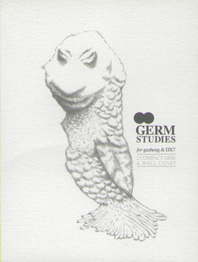www.splitrec.com
 |
Cooper seems to play the guzheng in every conceivable way, generating a range of sounds as broad and nuanced as the DX7. The two instruments, acoustic and electric, together produce highly colourful timbres and textures—squeaking, ringing, whistling, popping, vibrating, beeping, pulsing, resonating, grinding and scraping, with fleeting hints of melody and occasional sustained excursions, miked-up and mixed to add emphasis or presence. Cooper and Abrahams have orchestrated these organic and inorganic voices into tight musical statements, each unique for the choice and manipulation of its sonic elements. Both are experienced improvisers (including collaborations with the Splinter Orchestra), and with such a broad sonic palette available, they are working within a much expanded and very rich and rewarding compositional field.
The CD package includes a fold-out sheet of 198 drawings, one for each composition. The title of each drawing, combined with its imagery, creates its own micro-world. The evocative titles are often cryptic or ironic words or phrases, like crossword clues—for example, Acid Shower, Ability, Pulitzer, Mariah, Barrister Incident, Competitive Edge, Prejudice Stopper, Jogging, Eating Own Shoulder, Farnham—and the drawings range from a few abstract, squiggly lines to expressionistic doodles and complex, narrative tableaux that are variously funny, sad, happy, mad, realistic, surrealistic and satirical. It looks as if Germ Studies has emerged from a game similar to Pictionary (sonictionary?). There is Rosalie Coccario’s winged, white-faced snake flying away from the city and crying big tears of farewell (Pale Faced Adios) and Gerard Crewdson’s leering court jester and skull (Big Chill). The artists include well-known names from the world of contemporary music (Robin Fox and Jim Denley among others), while some drawings look to be by children, suggesting that Germ Studies is the product of an extended musical family.
Sometimes the music seems deliberately programmatic, parodying or exemplifying the concept embedded in the title—for example, Acid Shower suggests lots of nasty droplets, Jogging is rhythmic like footsteps, Bass Needle is a series of low frequency tones, and the onomatopoeic Crackle sounds crackly. Mingus Germs, presumably referencing the jazz musician Charles Mingus, incorporates jazz-like syncopation, though the hissy growling sound suggests a badly tuned radio or perhaps Mingus’s spirit. Some sounds resemble speech elements or the omnipresent electronic signals of contemporary life. Or the character of the music might seem to recreate the psychological or emotional state associated with the title. Overall, the Germ Studies sound world evokes the chaotically dense and polymorphous sonic panorama of the real world. But always the work is complex and layered and there is an overriding and beguiling musicality.
We’re not told whether each title was a response to the composition, whether the image was used as a graphic score or whether the title was used to trigger a musical gesture from which an improvisation developed. While on CD#1 each drawing and track generally share the same title, on CD#2 they don’t match, as if the tracks have been shuffled, so that each title/drawing is disconnected from its analogous composition, denying the listener the opportunity to read fixed meanings into the music or to draw conclusions about its genesis. Your imagination is teased in all directions by the potential interpretations of these images, phrases and sounds, inspiring vivid daydreams.
The musical language Cooper and Abrahams have created thus addresses the use of sound as an analogue to speech, text and imagery, and examines the relationships between sound, image, word, memory and meaning. Cooper and Abrahams are fine musicians and composers who have developed a closely shared musical sensibility, and this is an intriguing CD.
Chris Reid
© Chris Reid; for permission to reproduce apply to [email protected]








 back
back